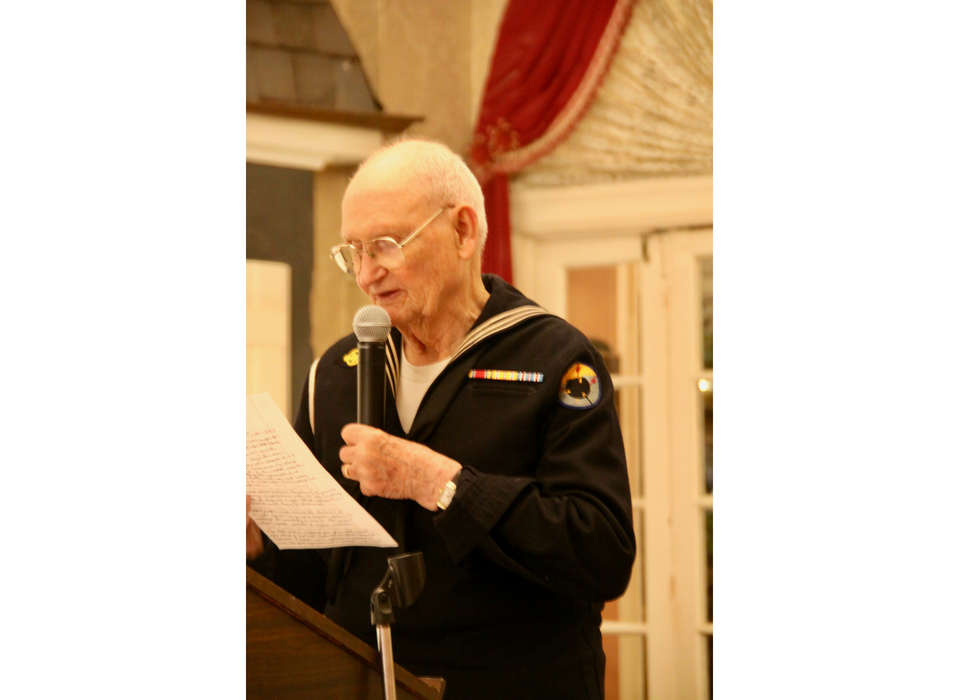On June 6, 2018, at The National WWII Museum’s annual D-Day Memorial event, I was lucky enough to interview Bill Clark, President of the Naval Mine Warfare Association. Here is the transcript of that interview (courtesy of the indefatigable efforts of Bill and his lovely wife, Glenda). I learned a ton from this interview, and I thought that friends of the Museum who couldn’t be there that day will, too.
Rob: We have a treat for you today. We have a WWII veteran, a fellow native of the Cleveland area, living in Sheffield Village, Ohio, and the President of the Naval Minewarfare Association: Bill Clark.
Bill: Thanks, Rob. It's my pleasure to represent the brave men of the Naval Minewarfare Association. My own WWII record is completely undistinguished, but I bask in the reflected glory of the men I've gotten to know in our organization.
Rob: We've heard about the battleships, carriers, and cruisers, but what was the role of the minesweepers in World War II?
Bill: I'll start with our motto "Where the fleet goes, we've been." As a matter of fact, we've all been sobered by the story of Dr. Baumgarten and uplifted by the deeds of these men who just received medals. One fact that Rob didn't mention was the thousands of mines which the Germans had laid and that's where the minesweepers come in. Actually, these heroes would not have been able to perform their feats until the mines had been dispersed from their path, permitting them to land and face the even greater dangers there.
Rob: Tell me about the minesweeper action during D-Day. They must have been very important.
Bill: That's very true. The statistics that I have are about Utah Beach. There was a document which the minesweeper forces utilized and it was called Operation Order 1-44. It dealt only with Operation Neptune, which dealt only with D-Day itself, June 6. Obviously, it was a large part of Operation Overlord, which covered the entire D-Day invasion. Now that invasion did not last one day, but went on for days and days and days with continuing casualties. One of our minesweepers, an AM, the USS Osprey, was sunk on June 5th, 1944, on the way to her assignment with the loss of 6 men. They were the first casualties of D-Day operations. There were 33 minesweepers involved with the Utah Beach operation, including 22 YMS's.
Rob: Were they a smaller boat?
Bill: Yes, they were--they were a wooden ship. You might say that makes a lot of sense because those mines--many of them--were magnetic and you want to have the minimal magnetic field possible. Also involved at Utah Beach were 11 AM's---I served on an AM--and they were steel vessels so that its magnetic field had to be minimized by an operation called degaussing. How large were they? The AM's had a complement of 105 persons, while the YMS's had a complement of 32 to 35 men.
Rob: I would think that sometimes those lanes that were cleared didn't stay that way.
Bill: That's right. That happened much more often in the later twentieth century wars. In the Korean War and the Vietnam War, instead of sweeping countless invasion sites, we were sweeping the same area over and over again. One thing about a mine--you don't even have to have a Navy to participate in mine warfare. A mine can be laid from a sampan, it can be laid from an airplane. So a lane once swept doesn't mean that it's once and forever clear. This sweeping is vital so the brave men in the invasion crafts can get in and face even greater dangers ashore.
Rob: I read the Operation 1-44: "The sweep will be completed at all costs. Under no circumstances will a ship fail to remain in formation." Stakes were high that morning, weren't they?
Bill: They were. When we talk about the formation, we're talking about an echelon formation, basically a V-shaped situation. If you're the lead ship in that formation you're in the greatest danger because your sweep mechanism covers a portion of those ships which follow. And there were very specific instructions in that order to which we referred: "You will sweep this particular path from Point A to Point Q and you will proceed at a particular speed, you will operate in such a fashion that you are a certain number of yards apart and you will create a pathway one mile wide. On the starboard or right side, you will lay red dan buoys, on the left or port side you will lay white dan buoys, so that the invasion craft will recognize that this is a swept path, perhaps not totally clean, but noticeably so."
Rob: You know we say the War in Europe ended in May and in the Pacific in August 1945, but that was not necessarily true for minesweepers. Right?
Bill: That's true. When the War's over, it's NOT over for minesweeping. As a matter of fact, as the supreme conquering nation, the United States wound up having to sweep not only mines we had laid to keep ships and maritime operations within enemy ports but also mines they have laid to prevent our entry into those ports. If you talk about the awarding of battle stars--and one of the gentlemen who was just honored had won 4 such stars--a tremendous source of pride for any of us who have earned even one of those awards. There were 27 sites in the Pacific which were designated for a battle star for post-war sweeping after WWII because it was such a dangerous operation. There is a saying amongst the minesweepers that ANY ship can be a minesweeper--ONCE!
Rob: I think I get that. Tell us about the Naval Minewarfare Association--how did it get started, how did you come to lead it, what's the concept?
Bill: The Association was started in 1982 by a group of 66 men who were meeting because they were all members of the Pearl Harbor Survivors Association. They decided "We can't belong to a ship's organization because our ships were all too small. Let's get together and pull those together that have all these commonalities." So that was done. This was 1982; let's say in 1941 at Pearl Harbor they were 19 years old. That means they're 60 years old when they're doing this. That holds up our philosophy that kids fight wars, old men join organizations, build monuments, and reminisce. That's how we got started and it has lasted 36 years. Unfortunately, we've announced regretfully that this is our final year of operation.
Rob: I think if we put a vote to the audience they might disagree with your decision. Why is that, Bill?
Bill: Well, just yesterday we had a Flag and Memorial Service as a part of our Convention and that is really the heart of our Convention each year--the 36th annual. We were aided by a Color Guard of Marines, our sister service. The fact that we honored the passing of 79 of our members is unbelievable and it points out the fact that age and mortality have gotten the best of us. There is no way that we were going to permit such a beloved organization to trickle out into the sands of time and disappear one by one. We said this has been a vital organization and we are going to go out with a bang and we are going to have a 5-day Convention in New Orleans. So, here we are!
APPLAUSE!!!
Rob: You chose the right city. I'm not sure I can add anything to that. I've got one more question for you, Bill, before I let you go. We're both from Cleveland, Ohio. Do you have a prediction for Cavs--Warriors?
Bill: Well, I coached basketball for 29 years--high school and college. The question is "do you know whether the ball is pumped up or stuffed up?" Yes, I do. The fact of the matter is that tonight you can look forward to a comeback Cavs' victory led by LeBron James and Kevin Love. Go, Cavs!
Rob: Bill, thank you so much.
------------
NOTE: Despite Bill’s prediction, the Golden State Warriors prevailed that night 110-102, en route to a sweep of the Cavaliers. The Cavs led 58-52 at halftime and might have justified Clark's faith, except for Kevin Durant pouring in 43 points in the game of his life.
Robert Citino, PhD
Robert Citino, PhD, is the former Samuel Zemurray Stone Senior Historian in the Jenny Craig Institute for the Study of War and Democracy.
Cite this article:
MLA Citation:
APA Citation:
Chicago Style Citation:





![Max Fuchs, New York City cantor, sings as Rabbi Sydney [sic] Lefkowitz, Richmond, VA, conducts the first Jewish services from Germany.](/sites/default/files/styles/max_650x650/public/2025-10/image1.jpg)



